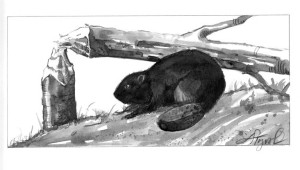
The next time you are driving through Moose Alley on U.S. Route 3 in Pittsburg, New Hampshire, or watching a moose wallow in a Green Mountain marsh, you can thank the beaver for helping make it possible.
The populations of beaver (Castor canadensis) and moose (Alces alces), though not directly linked, have experienced similar ups and downs over the past few centuries. The recent surge in moose numbers across the region is thanks, in part, to the recovery of beaver populations over the past half-century.
Beaver, which live throughout most of North America, are estimated to have numbered around 65 million animals when European exploration first began in earnest, roughly 400 years ago. Beaver pelts quickly became the primary item of trade between the colonies and France and England, with Native American and European trappers fanning out across the North America to supply the clothing and fashion demands of Europe.
The demand for beaver pelts for both local and export use continued through the Colonial period and into the nineteenth century until, by the late 1800s, the beaver was in serious decline all across its range (most of North America), including Vermont and New Hampshire.
Moose populations also declined during the first few centuries of European settlement. According to biologists with the New Hampshire Fish and Game Department, there were more moose than deer in New Hampshire at the start of European settlement, but by the late 1800s, fewer than 15 moose were documented in the entire state. This decline was partially due to the fact that moose were relatively easy targets for hunters, and the meat from a single animal could feed a family for months or be sold for much-needed cash.
But moose also suffered from the destruction of their preferred summer habitat: wetlands. Log drives and the damming of rivers for navigation and manufacturing reduced the amount of boggy land along riverbanks, while farmers drained interior wetlands whenever feasible to bring the rich, mucky soil into agricultural production.
Moose depend on nutritious wetland vegetation for forage and, perhaps equally important, rely on the water to cool themselves during the heat of summer. With their large bodies and dark fur, moose are better adapted to keeping warm in the winter than cool in the summer. They stick around all summer, keeping cool in the water, using the muck to keep pesky deer flies at bay, and even stashing their calves in the protection of the wetland, where predators are less likely to stumble across them on their appointed rounds.
In the early 1900s, as public demand for wild animal protection grew, conservationists began reintroducing beaver back to the twin states. In 1910, Vermont passed a state law protecting the beaver from hunting and trapping. New Hampshire released five beavers between 1926 and 1930. By the mid-1950s, thanks both to these governmental efforts and to the beaver’s natural inclination to seek out and colonize new habitat, beavers were once again building dams throughout both states.
Which is when the moose began their comeback. Beaver, in the course of building dams across small brooks and rivers and later abandoning those dams once their preferred food – typically poplar trees – has been exhausted, turn narrow-channeled streams flowing through closed-canopy forests into wide, marshy wetlands with lots of young vegetation growing quickly in the open, where the trees were either felled by the beaver or killed by the rising water behind the dam. In short, beaver going about their business create terrific moose habitat.
The moose-beaver link is only part of the reason for the moose’s recovery, of course. Hunting restrictions, an end to log drives, and the regrowth of much of the region’s forests have also been important factors. But the relationship between the beaver and the moose is the least obvious part of the story.
Although biologists feel that beaver have been fully occupying suitable habitat across New Hampshire and Vermont for some time, the rebound in the moose population is still underway, especially in the southern reaches of the two states. Vermont’s moose population increased 10-fold between 1988 and 1998, from roughly 200 animals to roughly 2,000. The increase has been at a similar rate in New Hampshire, with a herd now in the vicinity of 7,000 animals.
In fact, the growing moose population is a cause for concern, both for the risk of collisions with vehicles on roads and for the over-browsing of forest saplings that is starting to show up in the northern counties of both states. Without wolves or mountain lions on the scene, humans are the moose’s major predator. Both states have been slowly expanding their moose hunts over the past decade to try to keep moose populations in balance with their habitat.


Discussion *